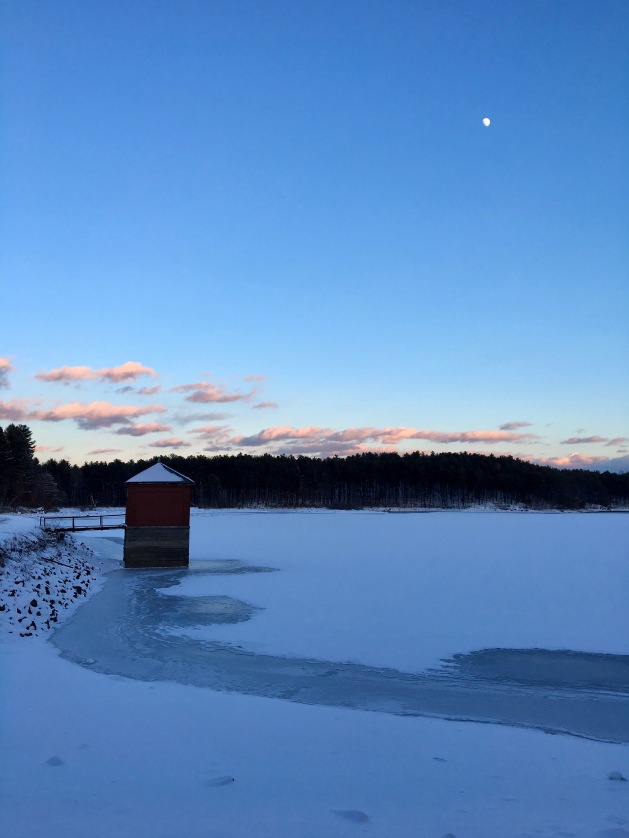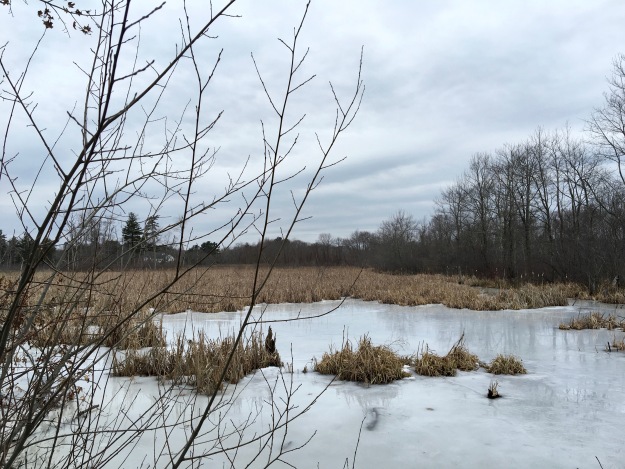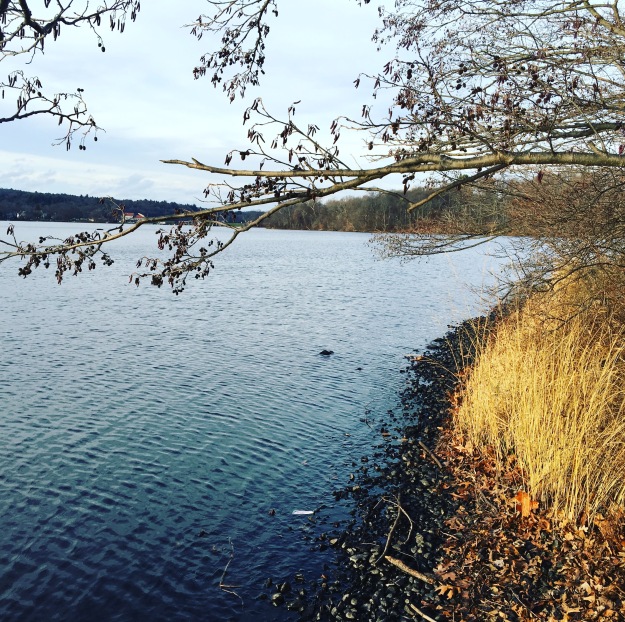We parked the car behind the Northshore Unitarian Universalist Church in Danvers earlier today and took a stroll along the Rail Trail and the Swamp Walk. Even after the recent rain, I have never seen it as dry.
Category: Outdoors Page 2 of 5
Strategic ambiguity at its finest: Keep out, but if you’re here anyway, don’t let your dog go swimming. Seen on a 5.9-mile walk on the roads around the Middlesex Fells this afternoon, including the semi-forbidden Middle and South Reservoirs.
[wpvideo 9E7AqLIU]

Looking south from the trail up Mount Washington at Mount Monroe, the Lake of the Clouds and the Lake of the Clouds Hut. Photo (cc) 2003 by Dan Kennedy.
I’ve never considered hiking the Appalachian Trail from one end to the other. It always struck me as too time-consuming and too boring. But for many years I loved backpacking in the mountains and hills of New Hampshire, Vermont and Western Massachusetts — and those journeys often involved traveling along sections of the AT.
Recently I read Philip D’Anieri’s new book about the AT, titled “The Appalachian Trail: A Biography.” It’s thoroughly enjoyable for anyone who loves the trail. D’Anieri’s approach is indeed biographical — he profiles some of the key people in the AT’s development, ranging from Arnold Guyot, a 19th-century Swiss immigrant scientist who was among the first people to advocate for the recreational uses of the Appalachian Mountains, to Dave Richie, Pam Underhill and Dave Startzell, government officials who in the 1970s rescued the AT from developers and helped make it what it is today.
D’Anieri also devotes a chapter to Bill Bryson, author of the 1998 bestseller “A Walk in the Woods.” So popular was Bryson’s entertaining tale about his failed attempt to hike the entire trail from Georgia to Maine that it led to an explosion of use — and overuse. I’ve gone on five 50-mile backpacking trips along the AT in the Berkshires and Vermont, three times as a Boy Scout and adult leader in the 1970s and twice as a scoutmaster in the 2000s. I can attest that the trail was far more crowded in the years after Bryson’s book was published than it was previously. Back in the ’70s we rarely encountered anyone; later on, we were never alone, encountering thru-hikers and wanna-bes on a daily basis.
Much of “A Walk in the Woods” focuses on Bryson’s relationship with his eccentric friend and hiking partner Stephen Katz. So I was taken aback when, some years ago, a few people who had encountered Bryson on the trail insisted that Bryson was alone and that Katz didn’t actually exist. I was pleased to learn from D’Anieri that Katz was real, although Bryson changed his name and some details about his personality.
It was scouting that introduced me to hiking and camping, activities that were entirely alien to my parents, and a real gift that led to my lifelong interest in the outdoors. I’ve hiked all 48 of New Hampshire’s 4,000-foot summits, finishing with North and South Hancock in 2007 with my son, Tim, as well as around 250 miles of the AT. Like many of us, I’ve slowed down as I’ve gotten older, though I still love hiking in the Middlesex Fells and on the North Shore. I haven’t ruled out a return to the mountains, either.
“For all that the AT is a human construction,” D’Anieri writes in conclusion, “its opening up to nature still has the power to inspire. We do not need a simplistic fantasy of unsullied Creation to appreciate the parts of the universe that aren’t us. It is enough to hold the contemporary world somewhat at bay, to make the intentional effort to see a bigger picture. Over 2,100 miles, in landscapes majestic and ordinary, that is the opportunity the trail affords us.”
I recommend D’Anieri’s book for anyone who has hiked along the Appalachian Trail, or has thought about it. As D’Anieri makes clear, the AT is not a natural wonder. Rather, it is the result of a deliberate effort on the part of a small group of visionaries — some eccentric, some difficult, but every one of them dedicated to the idea that the outdoors can inspire us all.
This post was originally included as part of last week’s Media Nation member newsletter. To become a member for just $5 a month, please click here.
Middlesex Fells between the Middle and South Reservoirs at about 3:30 p.m.
[wpvideo g27tv3iX]
Thank you so much for reading Media Nation in 2020. We always go out on the 30th, not the 31st, so we spent New Year’s Eve pretty much as we always do — with takeout pizza, the “Three Stooges” marathon and then watching the ball drop. It has been a terrible year, and not everyone made it to the finish line. I wish all of us a healthy (not just boilerplate this year) and much better 2021.
I took this shot toward the end of a hike through the Middlesex Fells around Winchester’s North Reservoir. If you’d like to see more, please click here.
Along the Wenham Rail Trail earlier today, just south of Route 97, looking west toward Connors Farm.
















